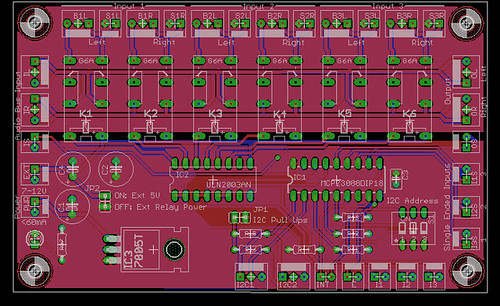nice work, atari.
Quote:
Originally Posted by linuxworks /img/forum/go_quote.gif
I see you allow for onboard power supply, for 5v. do you need to allow for a heatsink, maybe?
[…]
similarly, maybe a 5v passthru jack, so that if this board IS the 5v supply 'for the box' then maybe some other circuit needs 5v and can get it from this board?
|
Yes, it is thought to be run from something like 7.5V. The onboard regulator will make it independent from all other digital circuits.
A bypass jumper is a nice idea. Will be added.
I don't know if the 7805 is the regulator of choice. But it will be an hardware compatible (same package, same pinout) fixed voltage regulator.
Powerwise we are dealing with less than 60mA. (40mA for two active relays, some mA for the chips, some mA wasted and some mA for safety margin).
The final board will most probably have a fair amount of copper around the regulator as basic heat sink and enough space for a small heat sink – even though I do not think that you need it. The regulator will be flat, so that the relays are the highest parts (perhaps I have to rearrange the capacitors for that - more research needed.
Quote:
Originally Posted by linuxworks /img/forum/go_quote.gif
I like s1, letting you pick the i2c address of the board
|
If you want to have ore than one board in your final preamp or other boards using the same chip - it is a must. And never throw away flexibility without a cause
Quote:
Originally Posted by linuxworks /img/forum/go_quote.gif
I wonder if a chip of transistor-array (uln2003 style) would get rid of all the transistors, diodes and resistors? maybe it makes the layout easier? certainly would make the build go faster and also, the chip would be socketed and if anyone blows the chip, its 10 seconds to replace it. if you blow a transistor, you have to unsolder it. so, a slight serviceability gain if you use the dip chip for relay drive.
|
You stick to the uln2003?
The transistors, diodes and resistors are dirt cheap - so no problem on this side. I will play around with your idea. Don't know yet.
Quote:
Originally Posted by DKJones96 /img/forum/go_quote.gif
Why so many audio input/output sockets? One 4 pin can take care of the balanced and a 3 pin can do single ended. That would take you from 12 sockets down to only 6 and would make the board easier to work with along with knocking a couple bucks off the build cost.
|
Shouldn't it be at least 5 pins? (L+,L-,R+,R-,AGND). I a single star-ground board better (simply a board with a lot of ground connections)?
Quote:
Originally Posted by DKJones96 /img/forum/go_quote.gif
I don't see volume control?
|
Volume and SE/BAL conversion will be different boards. Since some people will like this and that for volume or SE/BAL conversion – they would throw away the input selector if they do not like the volume control
Quote:
Originally Posted by linuxworks /img/forum/go_quote.gif
his board is relay selection; I don't believe its intended to do volume control.
other boards and (sub)systems are planned for that (lol).
|
Yes, I am a software engineer in real world too – and we like independent subsystems with standard interfaces a lot
Quote:
Originally Posted by DKJones96 /img/forum/go_quote.gif
I like the ULN2003 idea. It does get rid of a lot on there. Those have built in diodes and everything making it cheaper yet again.
|
Ok, ok convinced.
Quote:
Originally Posted by DKJones96 /img/forum/go_quote.gif
What voltage are the relays running?
|
The circuit (including the relays) is intended to run on 5V. So 5V-Relays should be used.
Final board will come at the end of next week. If I have time & you are lucky
a single ended only board too.
Thanks for your interest and feedback!








